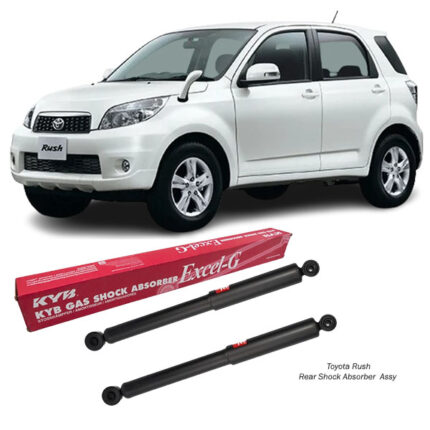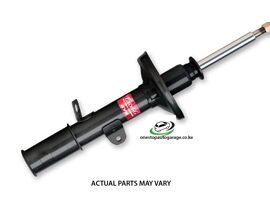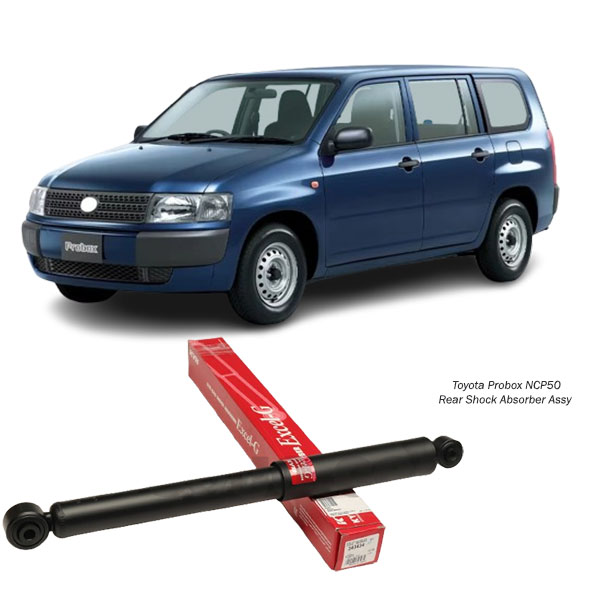-8%
Get Toyota Probox NCP50 Rear Shock Absorber Assy 343434 in Kenya
The Rear Shock Absorber Assembly (often abbreviated as “Rear Shock Absorber Assy”) is a crucial component of a vehicle’s suspension system. It plays a vital role in ensuring a smooth, stable, and safe ride by absorbing road shocks, reducing vibrations, and maintaining tire contact with the road. Without shock absorbers, driving would be a bumpy and uncomfortable experience, and handling would become unpredictable.
In this comprehensive guide, we’ll cover the function, types, signs of failure, maintenance tips, and replacement process of rear shock absorbers, ensuring you have all the knowledge to keep your vehicle in top shape! 🏎️🔧
1. What Is a Rear Shock Absorber Assembly? 🤔
A Rear Shock Absorber Assembly is a complete unit that includes the shock absorber, mounting hardware, and sometimes additional components like a spring in a strut-type suspension system. This assembly is designed to dampen road impacts and prevent excessive bouncing, ensuring the vehicle remains stable.
1.1 Role in the Suspension System
The rear shock absorber assembly:
✅ Absorbs shocks from road irregularities.
✅ Maintains tire contact with the road for better traction.
✅ Improves ride comfort by minimizing vibrations.
✅ Enhances vehicle stability during acceleration, braking, and cornering.
1.2 How It Works ⚙️
When the vehicle hits a bump or pothole, the suspension system compresses, and the shock absorber resists this movement by using hydraulic fluid or gas pressure to slow down the motion. This prevents excessive bouncing and ensures the vehicle remains in control.
2. Types of Rear Shock Absorbers 🚀
There are different types of shock absorbers, each with unique characteristics suited for different driving conditions.
2.1 Hydraulic (Oil-Filled) Shock Absorbers 🛢️
- Most common type.
- Uses hydraulic fluid to absorb and dissipate kinetic energy.
- Provides a smooth ride but can overheat under heavy use.
2.2 Gas-Charged Shock Absorbers ⛽
- Contains pressurized nitrogen gas in addition to hydraulic fluid.
- Reduces foaming and improves response time.
- Ideal for high-performance and off-road vehicles.
2.3 Coilover Shock Absorbers 🏁
- Combines a shock absorber and a coil spring in one unit.
- Used in sports and racing cars for adjustable ride height and stiffness.
- Provides superior handling but is expensive.
2.4 Mono-Tube vs. Twin-Tube Shocks 📏
- Mono-Tube: A single chamber design with better cooling and responsiveness.
- Twin-Tube: A dual-chamber design that provides a smoother ride but can suffer from fluid aeration.
3. Signs of a Failing Rear Shock Absorber Assembly 🚨
Over time, shock absorbers wear out, affecting vehicle performance and safety. Here are common symptoms of failing rear shocks:
3.1 Excessive Bouncing 🚗⬆️⬇️
- If your vehicle continues to bounce after hitting a bump, the shock absorbers may be worn out.
3.2 Uneven Tire Wear 🏁
- Worn shocks cause the tires to lose consistent road contact, leading to irregular tire wear patterns.
3.3 Poor Handling and Stability 🛑
- If your car leans excessively during turns or feels unstable at high speeds, the shocks may need replacement.
3.4 Leaking Hydraulic Fluid 💧
- If you notice oil leaks on or around the shock absorbers, it’s a sign of internal seal failure.
3.5 Noisy Suspension System 🔊
- Clunking, knocking, or squeaking sounds when driving over bumps can indicate worn-out shocks.
3.6 Longer Braking Distance 🚦
- Bad shocks reduce road grip, leading to increased stopping distances—a serious safety concern!
4. Causes of Rear Shock Absorber Wear 📉
Several factors contribute to the deterioration of rear shock absorbers:
4.1 High Mileage 🚗📅
- Shock absorbers typically last 50,000 to 100,000 miles, depending on driving conditions.
4.2 Rough Road Conditions 🏕️
- Driving on bumpy, uneven roads puts extra stress on shock absorbers, causing premature wear.
4.3 Overloading the Vehicle 📦
- Carrying excessive weight strains the suspension system and reduces shock absorber lifespan.
4.4 Exposure to Extreme Weather 🌡️
- Heat: Can cause hydraulic fluid to break down.
- Cold: Can stiffen rubber seals and reduce performance.
5. How to Replace a Rear Shock Absorber Assembly 🛠️
Replacing rear shock absorbers is a moderate-difficulty task. If you’re handy with tools, you can do it yourself, or you can take it to a mechanic.
5.1 Tools Required 🔧
✅ Jack and jack stands
✅ Socket wrench set
✅ Torque wrench
✅ Penetrating oil (for rusted bolts)
✅ New shock absorber assembly
5.2 Step-by-Step Replacement Process 🚗🔄
1️⃣ Lift the Vehicle Safely
- Use a jack to raise the car and secure it with jack stands.
2️⃣ Remove the Old Shock Absorber
- Locate the shock absorber and remove the bolts holding it in place.
- If bolts are rusted, use penetrating oil to loosen them.
3️⃣ Install the New Shock Absorber
- Align the new shock in place and tighten the bolts to manufacturer specifications.
4️⃣ Lower the Vehicle and Test Drive
- Ensure the installation is secure before taking a test drive.
💡 Tip: Always replace shock absorbers in pairs (both rear shocks) to ensure balanced performance.
6. Maintenance Tips for Long-Lasting Shock Absorbers 🏁
To extend the lifespan of your rear shock absorbers, follow these maintenance tips:
🔹 Inspect shocks regularly for leaks, cracks, or wear.
🔹 Avoid overloading the vehicle to prevent excessive stress.
🔹 Drive carefully on rough roads to minimize suspension impact.
🔹 Rotate and balance tires to reduce uneven shock absorber wear.
🔹 Check wheel alignment after replacing shocks for optimal performance.
7. Conclusion 🎯
The Rear Shock Absorber Assembly is essential for a smooth, stable, and safe driving experience. Understanding its function, types, and maintenance helps vehicle owners identify problems early and keep their suspension system in peak condition.
✅ Regular inspections and timely replacements prevent safety hazards.
✅ Choosing the right shock absorber type improves ride quality and handling.
✅ Proper maintenance ensures a longer lifespan for your suspension system.
If you suspect your shock absorbers are failing, don’t ignore the signs—get them checked and replaced if necessary! 🚗💨
Follow us on Facebook for more parts.



